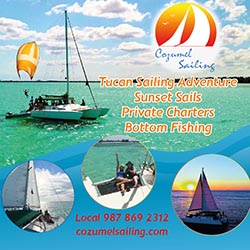Cozumel Sea Stars
Please Don’t Touch the Sea Life
With a Forward by the Editor
Editors note: We originally published this story in 2019. Recently, in our Cozumel 4 You Facebook group – a tourist posted a glowing review of an island tour company, their fabulous time, and included photos of them touching sting rays. In the photos, the staff of the boat were encouraging the contact, and even helping facilitating the harmful contact.
Although these photos were removed, they were quickly circulated through the Cozumel community. As a result, environmentalist Guadalupe Álvarez Chulin, demanded that the representatives of the National Commission of Protected Natural Areas (Conanp) take legal action against any tour operator company that promotes its activities with physical interactions between tourists and marine organisms.
Álvarez Chulin pointed out that the company was hoping the images would promote their services, however far from helping it, member of several sites, including the Cozumel 4 You FB group saw these images met with rejection and exhortation by members, including tourists, and locals, who often tagged local authorities urging for this company to be sanctioned.
While nothing has come of Guadalupe Álvarez Chulin’s complaint, the tour company has been removed from our group, and we’re running this story again in an effort to increase awareness that it’s NOT OK to TOUCH SEA LIFE.
Thanks for being conscious of the marine park rules and adhering to their regulations. For more information, check out their social media
- LSW

The Sea Star population in Cozumel is on the decline due to human interaction, here’s a few reasons you should never touch or remove them from the water
According to a representative from the National Commission of Natural Protected Areas (CONANP) the sea star population in the popular snorkel area “El Cielo” has suffered a drastic reduction, estimated at nearly 20% in the last
5 years, due to human interaction. Although the area falls within the National Marine Park of Cozumel, “Arrecifes de Cozumel” reports still surface of tourists removing the invertebrate from the ocean. In a recent interview, Cristopher Gonzalez Baca from CONANP, urged watersport operators to act as guardians of Cozumel’s natural resources and to educate their guests not to touch or remove the sea stars.
Sea stars extract oxygen from sea water so when they are removed from the water, it’s possible they can actually “suffocate” in the air. Also, the tiny suction cup “feet” (or ampulla) is where the oxygen is extracted is composed of a very tender tissue, and cilia, which is also easily damaged by handling.
The majority of the sea stars found in Cozumel waters are red cushion sea stars, or as they are known in latin, Oreaster reticulatus. Summer is their breeding season. They have a hard surface with blunt spines, and range in color from red, yellow to even brown.

Por favor no toquen la fauna marina.
Prólogo de la editora
Nota de la editora: Este artículo se publicó originalmente en 2019. En fechas recientes, en nuestro grupo de Cozumel 4 You en Facebook, un turista publicó una reseña lena de elogios a una compañía de excursiones de la Isla, mencionaron que pasaron un rato fabuloso e incluyeron fotografía de ellos tocando las mantarrayas. En las fotografías aparece el personal de la embarcación alentando a los turistas a tocar a las mantarrayas e incluso ayudaban a que hubiera el peligroso contacto.
Aunque estas fotografías se retiraron, rápidamente circularon entre la comunidad cozumeleña. Como resultado, la ambientalista Guadalupe Álvarez Chulim exigió a los representantes de la Comisión Nacional de Áreas Naturales Protegidas (Conanp) emprender acciones legales contra cualquier operador de excursiones que promueva esta clase de actividades con interacciones físicas entre turistas y organismos marinos.
Álvarez Chulim señaló que la empresa esperaba que dichas imágenes promovieran los servicios que ofrecen. Sin embargo, lejos de ayudarla, miembros de diversas páginas incluyendo a los del grupo Cozumel 4 You en Facebook, veían estas imágenes eran con censura y tanto miembros como turistas y habitantes locales, etiquetaban a las autoridades exhortándoles sancionar a la empresa.
Mientras que aún no se tienen resultados de la denuncia hecha por Álvarez Chulim, la empresa prestadora de los servicios de excursión ha sido retirada de nuestro grupo, y publicamos de nuevo esta historia en un esfuerzo por incrementar la sensibilización en cuanto a que NO ESTÁ BIEN TOCAR LA FAUNA MARINA.
Gracias por ser conscientes de las normas del Parque Marino y apegarse a los Reglamentos. Para más información, visiten sus redes sociales
- LSW
La población de las estrellas de mar en Cozumel va en descenso debido a la interacción humana. Aquí presentamos algunas de las razones por qué no deben tocarlas ni sacarlas del mar …
De acuerdo a un representante de la Comisión Nacional de Áreas Naturales Protegidas (CONANP) la población de estrellas de mar que reside en la popular zona de práctica de esnórquel conocida como El Cielo, ha sufrido una dramática reducción en los últimos 5 años y que se estima sea casi 20%; ello debido a la interacción de los humanos. No obstante que el área se encuentra dentro de el

Parque Marino Nacional de Cozumel “Arrecifes de Cozumel”, continúan saliendo reportes de turistas que retiran a los invertebrados del océano. En una entrevista reciente, Cristopher González Baca de la CONANP exhortó a los operadores de deportes acuáticos para que éstos actúen como protectores de los recursos naturales de Cozumel y que instruyan a sus clientes para que no toquen ni retiren las estrellas de mar.
Las estrellas de mar extraen oxígeno del agua, por ello, es posible que al retirarlas del mar se “asfixien” en el aire. Asimismo, sus “pies” en forma de pequeñas ventosas (o ampollas), donde se extrae el oxígeno, se componen de tejido suave y epitelio ciliar que también se dañan con facilidad al manipular.
La mayoría de las estrellas de mar que se encuentran en las aguas de Cozumel son las estrellas cojín, o como se les conoce en latín Oreaster reticulatus. La temporada de apareamiento es durante el verano. Su superficie es dura con espinas gruesas, y sus colores pueden ser rojo, amarillo e incluso café.
______________________________
Una ex yanqui de Connecticut quien llama hogar a Cozumel desde hace más de 15 años. Laura escapó al Caribe hace años, desplazándose de una isla a otra dando clases de BUCEO. Se dedicó a perder el tiempo en Jamaica y finalmente se detuvo en Cozumel para pasar unas vacaciones de 2 semanas que aún no terminan. Convenciendo a sus padres que pagaran una elegante universidad privada, obtuvo su título en Periodismo y Laura crea semanalmente Cozumel 4You, medios sociales y artículos promocionales sobre la Isla y también es moderadora en el grupo Cozumel 4 You en Facebook que actualmente cuenta con 25,000 miembros. Fabián, s umuy tolerante marido, desde hace mucho tiempo se resignó a no tener vida privada, pues se ha visto implicado en los diversos proyectos y planes que urde Laura. Son orgullosos padres de diversos perros y gatos rescatados. Mientras contempla su paso a través de la vida en el Caribe mexicano,Laura continúa siendo la pesadilla en la existencia de su muy tradicional suegra mexicana.
- Lost Diver Cozumel - April 4, 2025
- Cancun Airport Arrival Easier - April 4, 2025
- Cozumel Sargassum Seaweed - April 4, 2025
An ex-Connecticut Yankee who has called Cozumel home for over 18 years, Laura ran away to the Caribbean years ago, bumped around the islands teaching SCUBA diving, lost some time in Jamaica, and finally stopped in Cozumel for a 2 week vacation that hasn’t ended yet. With a degree in Journalism from a fancy private college she convinced her parents to pay for, Laura writes, edits, and creates the weekly Cozumel 4 You news, social media, and promotional articles about the island, as well as moderates the Cozumel 4 You Facebook group, which currently has over 25,000 members. Her long suffering husband, Fabian, has long since resigned himself to having zero private life, as he’s been involved in her various schemes and plots since his arrival. Proud parents to a variety of rescue dogs and cats, Laura continues to be the bane of her traditional Mexican mother-in-law’s existence, as she muses her way through life in the Mexican Caribbean. ______________________________ Una ex yanqui de Connecticut quien llama hogar a Cozumel desde hace más de 15 años. Laura escapó al Caribe hace años, desplazándose de una isla a otra dando clases de BUCEO. Se dedicó a perder el tiempo en Jamaica y finalmente se detuvo en Cozumel para pasar unas vacaciones de 2 semanas que aún no terminan. Convenciendo a sus padres que pagaran una elegante universidad privada, obtuvo su título en Periodismo y Laura crea semanalmente Cozumel 4You, medios sociales y artículos promocionales sobre la Isla y también es moderadora en el grupo Cozumel 4 You en Facebook que actualmente cuenta con 25,000 miembros. Fabián, s umuy tolerante marido, desde hace mucho tiempo se resignó a no tener vida privada, pues se ha visto implicado en los diversos proyectos y planes que urde Laura. Son orgullosos padres de diversos perros y gatos rescatados. Mientras contempla su paso a través de la vida en el Caribe mexicano, Laura continúa siendo la pesadilla en la existencia de su muy tradicional suegra mexicana.
1 Comment
Leave a Reply Cancel reply
Cozumel Sargassum Seaweed
Cozumel Sargassum Seaweed Spring is Here & so is Sargassum The sargassum...
Reef Care Parrotfish Slaughter Cozumel
Reef Care Parrotfish Slaughter Cozumel “Caring for our reefs is everyone’s responsibility,”...
Cozumel Flamingo
Cozumel Flamingo Flamingos Finally Return to Cozumel Punta Sur Representatives...
Cozumel Lifeguards Rescue Rip Current
Cozumel Lifeguards Rescue Rip Current Cozumel’s Lifeguards Rescue Swimmer from Strong Rip...





















Thanks for the article on the sea stars. How do you get local tour boat operators to leave them alone? I was on a boat out to El Cielo and was searching the waters for a sea star and one of the crew picked one up to show me. Thankfully he didn’t take it out of the water. I asked him urgently,several times, to please put it down which he finally did.